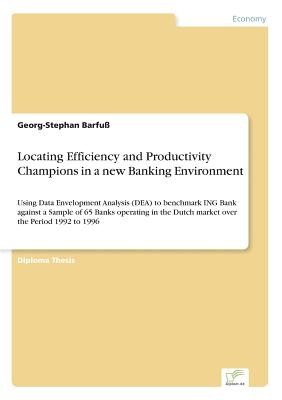
- We will send in 10–14 business days.
- Author: Georg-Stephan BarfuÃ
- Publisher: Diplom.de
- Year: 1999
- Pages: 134
- ISBN-10: 3838617916
- ISBN-13: 9783838617916
- Format: 14.8 x 21 x 0.8 cm, softcover
- Language: English
- SAVE -10% with code: EXTRA
Locating Efficiency and Productivity Champions in a new Banking Environment (e-book) (used book) | bookbook.eu
Reviews
Description
Inhaltsangabe: Abstract: Part one of the thesis states the changes and developments that have markedly altered the banking world. This analysis is followed by a discussion about the consequences these transformations have on credit institutions in general. Special focus is devoted to the universal bank, the advantages and disadvantages of which are linked to the changes mentioned above. Part two begins with the introduction of a prominent member of the universal banking type: ING Group and its banking operations in the Netherlands, ING Bank, respectively. Both are shortly introduced and their performance measured with the help of "traditional" tools. To go deeper than the mere standard comparison of data given in annual reports, however, a new method will be introduced that approximates the relative efficiency and productivity of companies - in this case banks. This method is called "Data Envelopment Analysis" (DEA) and offers some advantages that complement "traditional" ways of assessing company performance. DEA is then run with the help of a special software programme, processing data about 65 credit institutions that are operating in the Dutch market. The focal point of interest in this analysis is on the performance of ING Bank as measured by DEA. This kind of "benchmarking" will be performed in two ways: first statically (comparison within a certain year), then dynamically (comparison over the years 1992 to 1995). Subsequently, the credit institutions will be summed up into categories like "best-practice" or "worst-practice" to conduct further analyses. The conclusions from this analysis is then taken as a basis to evaluate, whether ING Bank has been able to adopt to the growing demands of an ever faster changing banking environment. The concluding chapter relates mainly to an additional usage of DEA that is not related to benchmarking directly. DEA and the results it yields can be used to find out, which firms are especially successful in incorporating th
EXTRA 10 % discount with code: EXTRA
The promotion ends in 18d.17:13:51
The discount code is valid when purchasing from 10 €. Discounts do not stack.
- Author: Georg-Stephan BarfuÃ
- Publisher: Diplom.de
- Year: 1999
- Pages: 134
- ISBN-10: 3838617916
- ISBN-13: 9783838617916
- Format: 14.8 x 21 x 0.8 cm, softcover
- Language: English English
Inhaltsangabe: Abstract: Part one of the thesis states the changes and developments that have markedly altered the banking world. This analysis is followed by a discussion about the consequences these transformations have on credit institutions in general. Special focus is devoted to the universal bank, the advantages and disadvantages of which are linked to the changes mentioned above. Part two begins with the introduction of a prominent member of the universal banking type: ING Group and its banking operations in the Netherlands, ING Bank, respectively. Both are shortly introduced and their performance measured with the help of "traditional" tools. To go deeper than the mere standard comparison of data given in annual reports, however, a new method will be introduced that approximates the relative efficiency and productivity of companies - in this case banks. This method is called "Data Envelopment Analysis" (DEA) and offers some advantages that complement "traditional" ways of assessing company performance. DEA is then run with the help of a special software programme, processing data about 65 credit institutions that are operating in the Dutch market. The focal point of interest in this analysis is on the performance of ING Bank as measured by DEA. This kind of "benchmarking" will be performed in two ways: first statically (comparison within a certain year), then dynamically (comparison over the years 1992 to 1995). Subsequently, the credit institutions will be summed up into categories like "best-practice" or "worst-practice" to conduct further analyses. The conclusions from this analysis is then taken as a basis to evaluate, whether ING Bank has been able to adopt to the growing demands of an ever faster changing banking environment. The concluding chapter relates mainly to an additional usage of DEA that is not related to benchmarking directly. DEA and the results it yields can be used to find out, which firms are especially successful in incorporating th


Reviews